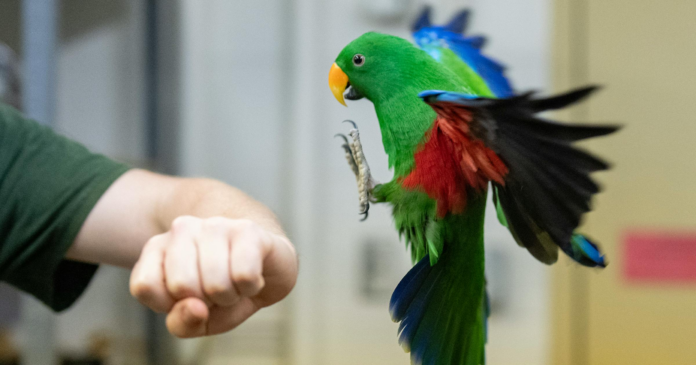Danny, a capybara, eats his breakfast at the Lake Superior Zoo. Danny was one of hundreds of animals transferred to the zoo after SeaQuest in Roseville closed in March 2025. At SeaQuest he was sequestered to a small enclosure compared to the large, open-air space he now has. (Alex Kormann/The Minnesota Star Tribune)
Danny is a large rodent, with the good looks of a guinea pig. He has moved in with a kangaroo and wallabies, and a pond and barn will be built to give them all more options and space. To find him a girlfriend, Danny has been placed on the Species Survival Plan, an Association of Zoos and Aquariums-managed breeding program.
Capybaras like to dig, so he roams in a large fenced enclosure outside and eats greens. So far, he likes to lie by the fence near visitors when they approach. Duluth’s cold weather will keep him inside much of the winter, so he’ll also get indoor space.
It’s all a long way from his past life, where he lived indoors in tight quarters, never experiencing the world outside.
“Danny just didn’t have the chance to have a personality, and now he’s figuring it out,” said Cassy Siirila, who cares for Danny.
Most of the 170 budgies (a type of parakeet) the zoo acquired have been transported to other zoos that had more space. The technicolor-bright Eclectus parrots Jalapeño and Habanero are still in an off-exhibit space, but will have a new enclosure soon to be part of zoo education programs.
Fish in quarantine
Animals and fish placed in other facilities in Minnesota are also flourishing, caretakers say.
The Minnesota Zoo welcomed nearly 130 new residents, mostly tropical fish. Most of those fish are still in quarantine as they heal from a parasitic infection, said Kurt Heizmann, director of animal care.
Others, like the crested porcupines, needed dental work or other overdue medical care. But two wallabies are now on exhibit, along with a sloth and a three-banded armadillo.
The Great Lakes Aquarium took in an electric eel, a couple of white sturgeon and some trout. All are thriving, said husbandry director Darin Reinke, especially an eel who accidentally ingested rocks and had to have them removed. Rocks were part of his Roseville enclosure and shouldn’t have been, Reinke said.
The work of the Minnesota, Como and Lake Superior zoos and other reputable facilities to ensure animals were rescued “was a huge undertaking,” Heizmann said.
“Our biggest thing is making sure these animals were given a second chance and a new home that is passionate about these animals,” he said, while caring for them and their well-being.
Xerox, a tegu, sits under a sunbathing lamp in a temporary enclosure at the Lake Superior Zoo. Xerox is one of hundreds of animals transferred from SeaQuest after it closed in March. (Alex Kormann/The Minnesota Star Tribune)
It was also important for animal conservation education, Larson said.




